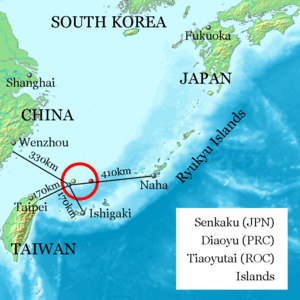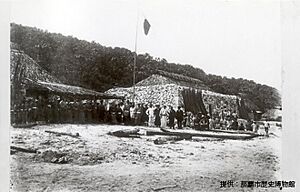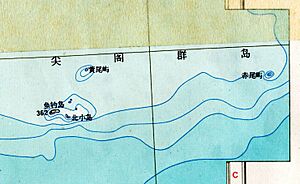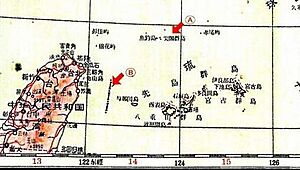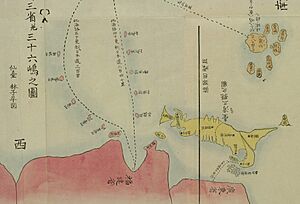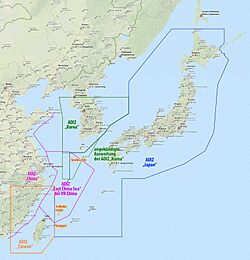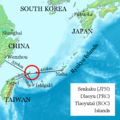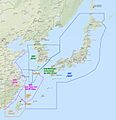Senkaku Islands dispute facts for kids
The Senkaku Islands dispute is a disagreement over a group of islands. These islands are called the Senkaku Islands in Japan, the Diaoyu Islands in China, and Tiaoyutai Islands in Taiwan. The islands are not lived on by people.
Japan has controlled these islands since 1895. However, from 1945 to 1972, the United States managed them as part of the Ryukyu Islands. The islands are near important shipping routes and good fishing areas. There might also be oil under the sea nearby.
According to an expert named Lee Seokwoo, China started to claim the islands in the late 1970s. This happened when people found out there might be oil reserves there. Taiwan also says the islands belong to them.
Japan says it explored the islands in the late 1800s and found them to be terra nullius (land belonging to no one). Japan believes China agreed to this until the 1970s. China and Taiwan say old documents show China owned the islands before the First Sino-Japanese War. They believe Japan took the islands and should give them back, like other lands Japan took in 1945.
The islands are part of the Treaty of Mutual Cooperation and Security between the United States and Japan. This means if Japan defends the islands, the United States would need to help Japan.
In September 2012, the Japanese government bought three of the islands from their private owner. This caused big protests in China and Taiwan. Japan bought them to stop a Tokyo governor from doing something more extreme. But China saw the purchase as Japan trying to fully claim the islands.
On November 23, 2013, China created an Air Defense Identification Zone over the East China Sea. This zone includes the Senkaku Islands. China said all planes flying into this zone must share their flight plans and radio information.
Contents
Understanding the Islands
The Senkaku Islands are in the East China Sea. They are located between Japan, China, and Taiwan. This group of islands has five islands and three small, rocky areas. None of them have people living on them. Their sizes range from 800 square meters to 4.32 square kilometers.
How the Dispute Started
After the Meiji Restoration in Japan, the Japanese government officially made the Ryukyu Kingdom into Okinawa Prefecture in 1879. The Senkaku Islands were between the Ryukyu Kingdom and the Qing dynasty (China). This made them a border area for the first time.
In 1885, the Japanese Governor of Okinawa, Nishimura Sutezo, asked the government to take control of the islands. But Inoue Kaoru, Japan's Minister of Foreign Affairs, was worried. He noted the islands were near China and had Chinese names. He also knew a Chinese newspaper had said Japan was taking islands near China. Inoue feared that claiming the islands would make China suspicious.
Because of Inoue's advice, Yamagata Aritomo, the Minister of the Interior, said no to the request. He insisted that this issue should not be shared with the news.
On January 14, 1895, during the First Sino-Japanese War, Japan officially added the islands to Okinawa. Japan said it had explored the islands since 1884. They claimed the islands were terra nullius (land belonging to no one). Japan also said there was no proof that China had ever controlled them.
After China lost the war, both countries signed the Treaty of Shimonoseki in April 1895. This treaty said China would give Japan "the island of Formosa (Taiwan) along with all islands belonging to it." However, the treaty did not clearly list which islands belonged to Formosa.
The Treaty of Shimonoseki was later replaced by the Treaty of San Francisco in 1951. This happened after Japan lost Second World War. In the new treaty, Japan gave up control of Taiwan/Formosa and all its related islands.
There is a disagreement about whether the Senkaku Islands were part of the "islands belonging to Formosa" in the 1895 treaty. China and Taiwan say they were. They point to Yamagata Aritomo's earlier decision in 1885 not to claim the islands.
Japan says the islands were placed under the United States' control as part of the Ryukyu Islands. This was done under the San Francisco Peace Treaty. Japan notes that China did not object to this at the time.
In 1972, the United States ended its control of Okinawa and the Ryukyu Island chain, which included the Senkaku Islands. The U.S. gave control of the islands back to Japan as part of Okinawa. However, the U.S. did not say who the true owner of the islands was.
Lee Seokwoo, a Korean expert, believes Japan has a stronger claim. He says the important date for the dispute is when Japan officially stated its position in 1971.
China and Taiwan's Views
Before the 1970s
Before the 1970s, neither China nor Taiwan officially claimed the Senkaku Islands. They did not argue against other countries' claims. Several maps, newspapers, and government papers from both countries after 1945 used the Japanese name for the islands. Some even said they were Japanese land. It was only in the early 1970s that Chinese documents started calling them the Diaoyu Islands and Chinese territory.
For example, the People's Daily, a Chinese newspaper, called the islands "Senkaku Shotō" in 1953. It said they were part of the U.S.-controlled Ryukyu Islands.
A Chinese government document from 1950 also used the Japanese names "Senkaku shotō" and "Sentō Shosho." It showed China saw the islands as part of the Ryukyu Islands. The document even suggested studying if the Senkaku Islands should be part of Taiwan because they were close. This shows China did not think they were already part of Taiwan.
Many official maps from China and Taiwan after 1945 also show they did not claim the islands. They showed the islands as Japanese territory. China has since tried to fix "wrong" maps.
- A Chinese atlas from 1969 used the Japanese name "Senkaku Guntō" for the islands. The largest island, Uotsuri Island, was called "Uotsuri-shima" (魚釣島).
- From 1946 to 1971, the Taiwan Statistical Abstract said Taiwan's easternmost point was Mianhua Islet. It did not include the Senkaku Islands. In 1972, after Taiwan said the islands belonged to Yilan County, the description changed. It then included the Senkaku Islands.
- A world atlas from 1965 in Taiwan showed the Diaoyu Islands with Japanese names like Uotsuri-shima. It clearly drew a border between Taiwan and the Senkaku Gunto. In 1971, this changed, and the border moved to include the islands as part of Taiwan.
- A world atlas published in Beijing in 1958 showed the Senkaku Islands as Japanese territory. It used the Japanese names "Senkaku Guntō" and "Uotsuri-Jima."
- A junior high school geography textbook in Taiwan in 1970 called the islands "Senkaku Gunto." It showed them as part of the Ryukyu Islands, not Taiwan. In 1971, the name changed to Diaoyutai Islands, and the map was redrawn to include them in Taiwan.
After the 1970s
China did not claim the islands while the U.S. controlled them. But in 1971, when the U.S. was preparing to give control back, China made formal claims. A study in 1968 found possible oil nearby. Many believe this is why China started claiming the islands. Chinese Premier Zhou Enlai confirmed this in 1972.
China and Taiwan say the dispute is a result of Japan's past actions. They argue that China could not claim the land after World War II because of its own civil war. Both China and Taiwan claim the islands based on these points:
- They say China discovered and recorded the islands on maps long ago.
- The islands were China's defense against Japanese pirates from the 1300s to 1911.
- An 18th-century Japanese map showed the islands as part of China.
- Japan took control of the islands in 1895 during the First Sino-Japanese War.
- The Potsdam Declaration after World War II limited Japan's land. China says this means the islands should not be Japan's.
- China formally protested the 1971 U.S. transfer of control to Japan.
China says it knew about the islands since at least 1372. They say the islands were part of China since 1534. The earliest record of Diaoyutai is from a Chinese book in 1403. This book listed islands travelers passed on a trip to the Ryukyu Kingdom.
By 1534, all the main islands were named in a Chinese book. They were the Ming dynasty's sea defense border. One island, Chihweiyu, marked the edge of the Ryukyu Islands. China and Taiwan see this as proof the islands were not part of the Ryukyu Islands.
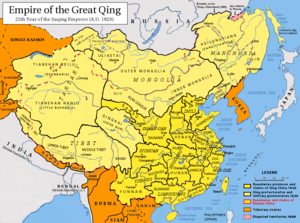
The First Sino-Japanese War started in 1894. After China lost, both countries signed the Treaty of Shimonoseki in 1895. This treaty said Taiwan and its related islands would go to Japan. China and Taiwan argue that Japan did not include the islands as part of Okinawa before 1894. They say Japan only added them after China gave up Taiwan.
Japan says the islands were not given up by this treaty. Japan says it explored the islands in 1885 and found no signs of Chinese control. Japan officially added the islands in 1895.
China and Taiwan say the islands were not mentioned when the U.S. discussed the Ryukyu Islands with China. They also say Japan's private deals to lease and buy the islands did not change their legal status.
In April 2012, Taiwan refused China's offer to work together on the dispute. Taiwan said it would not deal with China because they already have their own disagreements.
Some Chinese experts say the 1953 People's Daily article means the Ryukyu Islands should be independent from Japan. Some even say China should claim all of the Ryukyu chain, including Okinawa.
Japan's View
The Japanese Ministry of Foreign Affairs says the Senkaku Islands are clearly part of Japan. They say this is based on history and international law. Japan says it controls the islands and there is no real dispute over who owns them.
Japan gives these reasons:
- The islands were not lived on and showed no signs of being controlled by China before 1895.
- The islands were not part of Taiwan or the Pescadores Islands. These were given to Japan by China in 1895. So, Japan did not give them up later in the San Francisco Peace Treaty.
- A person from Okinawa started fishing and working around the islands in 1884. The Japanese government approved his lease of the islands in 1896. He brought 248 workers and ran businesses like fishing and collecting bird feathers. Japan says this shows its clear control over the islands.
- The United States controlled the islands from 1945 to 1972. But Japan has controlled them since 1972.
- Japan says Taiwan and China only started claiming the islands in 1971. This was after a 1969 United Nations report found possible oil and gas nearby.
Examples of Japan's control since 1972 include:
- Patrols and law enforcement, like stopping illegal fishing boats.
- Collecting taxes from private owners of some islands.
- Managing some islands as state-owned land.
- Offering Kuba Island and Taisho Island to the United States for use since 1972.
- Doing research on the islands, like for fishing or studying birds.
Japan says its 1885 survey found the islands were terra nullius. This means they belonged to no one. Japan officially added the islands in 1895.
Japan says neither China nor Ryukyu claimed the islands before. They say Chinese documents only prove that Kumejima, the first island with people, belonged to Okinawa.
A Chinese record from 1617 shows China did not control the Senkaku Islands. It says the Chinese coast guard controlled islands only about 40 kilometers from the mainland. The Senkaku Islands are about 330 kilometers away. This supports Japan's view that China did not control the islands back then.
In 1921, a Chinese Consul in Nagasaki wrote a letter about a shipwreck. He referred to "Senkaku Islands, Yaeyama District, Okinawa Prefecture, the Empire of Japan." This letter is on display in a museum.
Former President of Republic of China, Lee Teng-hui, said in 2012 that the islands "certainly belong to Japan." He had said similar things before.
United States' View
On December 25, 1953, the U.S. Civil Administration of the Ryukyus included the Senkaku Islands in the Ryukyu Islands' boundaries. While the U.S. managed the islands, the U.S. Navy built firing ranges there. They paid rent to the son of the first Japanese settler.
During talks for the Treaty of San Francisco, the U.S. said Japan had "residual sovereignty" over the Ryukyu Islands. This meant the U.S. would not give its control of the Ryukyu Islands to any country other than Japan. U.S. Presidents Eisenhower and John F. Kennedy confirmed this. Since the U.S. did not separate the Senkaku Islands from the Ryukyu, this idea seemed to include the Senkaku Islands.
In May 1971, a U.S. Central Intelligence Agency report said Japan's claim to the islands was strong. It said China would have to prove its ownership. The CIA also noted that the dispute likely started because of the discovery of oil in 1968.
On June 7, 1971, President Richard M. Nixon confirmed Japan's "residual sovereignty" over the Senkaku Islands. This was just before a deal to return Okinawa to Japan.
However, the Nixon Administration later changed its position. On October 20, 1971, U.S. Secretary of State William Rogers sent a letter to Congress. It said the U.S. returning control of the islands to Japan would not affect any claims. It stated the U.S. had no claim to the islands and believed the dispute was for the involved countries to solve. Some experts believe this change was due to the U.S. trying to improve relations with China.
In 1978, Japan asked the U.S. to support its view, but the U.S. refused. It did not want to get involved in the dispute. The U.S. Navy also stopped using a firing range near the islands to avoid problems.
Since 2004, top U.S. officials have said that because Japan controls the islands, they are covered by the 1960 Treaty of Mutual Cooperation and Security between the United States and Japan. This treaty requires the U.S. to help Japan defend the islands if attacked.
In November 2012, the U.S. Senate agreed that the islands are covered by this treaty. In May 2013, the U.S. Department of Defense criticized China's claims over the islands. In July 2013, the Senate passed a resolution condemning China's actions near the islands.
In April 2014, U.S. President Barack Obama said the U.S. security treaty with Japan covers the Senkaku Islands. He was the first U.S. president to say this. In November 2020, Joe Biden also confirmed this to Japan's Prime Minister. On January 24, 2021, U.S. Defense Secretary Lloyd Austin repeated this commitment.
Other Ways to Solve the Dispute
When Taiwan and Japan started diplomatic relations in 1972, they decided to put the dispute aside. Deng Xiaoping, a Chinese leader, said it was fine to wait 10 years. He believed future generations would be wiser and find a solution.
In 1969, a United Nations group found possible oil and gas near the islands. For many years, there were talks about jointly developing these resources. But these efforts did not succeed.
In 2008, a first agreement was made to jointly develop resources. But this agreement only covered an area far from the islands. In 2009, a special phone line was agreed upon for military communication, but it was never set up.
Why the Conflict is Happening
People have different ideas about why the conflict over the Senkaku Islands has grown. Japan's government says it is not a "territorial dispute."
Some news groups have tried to explain the reasons:
- Some say the Senkakus are like a "proxy war." This means it's a conflict where bigger powers are fighting through smaller issues.
- Others say the islands are just an excuse. They believe China is using the islands to make bigger claims in the region.
- Some think the dispute was a way to distract from China's internal power struggles.
- Others suggest there's a lack of clear leadership in China. They say different government groups might be trying to look strong.
The history of the islands is important for understanding each new event in this ongoing situation.
Recent Events
Taiwan and China first claimed the islands publicly in 1971. But there were no big problems until the 1990s. Since 2004, however, many events have made the dispute worse. These include naval encounters, fighter jets being sent, diplomatic talks, and large public protests.
Incidents Near the Islands
In 1996, an activist from Hong Kong drowned trying to swim to one of the islands. Since 2006, boats from China, Taiwan, and Hong Kong have entered waters Japan claims around the islands. Sometimes, these were protesters. For example, in 2006, activists were stopped by the Japanese Coast Guard. In 2008, Taiwanese activists and Chinese Coast Guard boats went very close to the main island. They sailed around it to show their claim.
In 2012, a Taiwanese Coast Guard vessel and a Japanese Coast Guard vessel crashed. The Taiwanese boat was with activists. In August 2012, Hong Kong activists swam ashore after their boat was stopped. They were held and then sent back home. In January 2013, Japanese patrols used water cannons to stop a Taiwanese activist boat from landing.
There have also been problems with Chinese or Taiwanese fishing boats in waters Japan claims. In 2008, a Taiwanese fishing boat and a Japanese patrol vessel crashed. Japan later apologized and paid money to the boat owner.
On September 7, 2010, a Chinese fishing boat crashed with two Japanese Coast Guard boats. This happened after Japan told the trawler to leave. Japan arrested the Chinese captain. Japan held the captain for 17 days. Both countries blamed the other. China demanded the captain's release. When China arrested four Japanese people, Japan released the captain.
Japanese government boats patrol the area. Japanese citizens also enter the area. In 2010, nine Japanese boats fished there to show Japan's claim. In 2012, a group of 150 Japanese activists went to the islands. The Japanese government did not let them land. But some swam ashore and put up a Japanese flag.
Ships and planes from China and Taiwan have also entered the disputed area. In 2012, there were over 40 sea entries and 160 air entries. In December 2012, a Chinese government plane entered Japanese airspace for the first time. Japan sent eight F-15 fighter jets in response. Japan formally protested to China.
The most direct clash happened in September 2012. Seventy-five Taiwanese fishing boats were with ten Taiwanese Coast Guard vessels. The Taiwanese and Japanese Coast Guard ships clashed. Both sides used water cannons and loudspeakers to state their claims.
Military tensions continued in 2013. Both sides sent fighter planes. In February, Japan said a Chinese warship had aimed its weapons radar at a Japanese destroyer and helicopter. China said its ships were just training. In October 2013, China warned that shooting down its drones would be an "act of war." Chinese state media said a war was possible.
In April 2014, a newspaper reported that Chinese Coast Guard patrols had greatly decreased since October 2013.
In June 2020, the Japanese Coast Guard said Chinese government ships had been in the waters near the islands for a record 67 days in a row.
On June 4, 2022, Chinese and Russian military activity was seen near the islands. A Russian warship sailed in the "contiguous zone" for over an hour. Then a Chinese warship sailed there for 40 minutes. This was the fourth time a Chinese warship entered this zone since 2016.
On March 30, 2023, the Japan Coast Guard reported that Chinese government vessels entered Japanese waters near the islands. They stayed for a record 80 hours and 36 minutes.
Number of Chinese vessels entering the waters near the Senkaku Islands.
Number of times the Japan Air Self-Defense Force had to send planes against foreign aircraft (2006–2019)
- China
- Others
Diplomatic Efforts
The governments have protested and criticized each other. For example, Taiwan called back its top representative to Japan after the 2008 crash. China protested the 2012 activist incident. The 2010 boat crash made tensions much higher.
In 2012, Taiwan's President Ma Ying-Jeou suggested the East China Sea Peace Initiative. This plan called for sharing the region's resources, including the Senkaku Islands. It suggested using peaceful talks and international law.
Public Protests
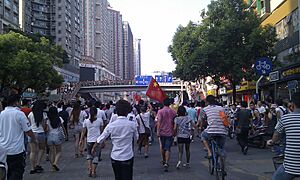
The U.S. plan in 1971 to give the islands to Japan led to the Baodiao movement. This movement started with students from Taiwan and Hong Kong in the U.S. It then spread to Taiwan and Hong Kong.
There have been many public protests in all three places. The 2010 boat crash caused big protests in Japan, China, and Taiwan. In 2012, major protests started in August. This was after reports that Japan might buy the islands. Protests continued after Japan bought them. At their peak, there were protests in 85 Chinese cities, Hong Kong, and the U.S. There were also protests in Taiwan. Many of these protests included violence, damage, and fires against Japanese things.
Military Actions
China decided to create an "Air Defense Identification Zone" around the islands. China's defense ministry said this was to "guard against potential air threats." Japan called this move "very dangerous." On November 23, 2013, China sent fighter jets to patrol the zone.
On November 26, 2013, the United States flew two B-52 bomber planes through the zone without problems. The U.S. military said it would keep flying in the region. It said it would not share flight plans or radio information with China for this zone.
Since then, U.S., South Korean, and Japanese military planes have flown through it. China then sent fighter jets to patrol the area.
A 2012 poll showed that 91% of people in mainland China thought military action should not be ruled out. Only 41% in Taiwan thought so.
To help find intruders, Japan opened a radar station on Yonaguni island on March 28, 2016. This made China very angry.
On February 1, 2021, China passed a new law. This law allows the Chinese Coast Guard to use deadly force if "national sovereignty" is violated. Japan and the U.S. criticized this law. It caused tension because it applies to disputed waters, including around the Senkaku Islands. On February 6, 2021, Chinese Coast Guard vessels entered Japanese waters near the islands for the first time after the law passed.
On June 30, 2022, Japan's Ministry of Defense announced it would build 12 new patrol vessels. These ships will help increase patrols around the southwestern Ryukyu Islands, including the Senkaku Islands. They are meant to improve security and gather information. The ships are expected to be delivered starting in April 2023.
Education
In 2014, China complained about Japan's plans to teach students about Japan's ownership of the islands.
Other Events
- In April 2014, a U.S. General said his forces were ready to defend the Senkaku Islands if China attacked. China replied that its military could take the islands anytime.
- On June 9, 2016, three Russian warships and a Chinese Navy warship sailed near the 12-nautical-mile zone around the islands. Japan quickly told the Chinese warship to leave. This was the first time the Chinese Navy was involved in the dispute.
- On August 11, 2016, a Chinese fishing boat sank after hitting a Greek ship. The Japan Coast Guard rescued 6 of the 14 crew members. Japan said China "expressed appreciation" for the rescue.
Fishing Rights
The issue of who owns the islands has been avoided in fishing agreements. In a 1997 fishing agreement, the Senkaku Islands were not part of China's exclusive economic zone. But Japan said it would not stop Chinese boats from fishing there. Some Chinese sources say this means Japan gave up its exclusive fishing rights.
In 2014, Taiwan and Japan made an agreement about fishing in the waters around the islands.
Images for kids
-
Qing dynasty in 1820, with provinces in yellow, military governorates and protectorates in light yellow, tributary states in orange.
-
Demonstration in Shenzhen, China on 17 September 2012


